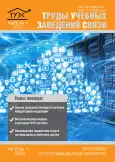Иерархическая модель для проектирования систем на основе микроконтроллеров защищенными от киберфизических атак
- Авторы: Левшун Д.С.1
-
Учреждения:
- Санкт-Петербургский Федеральный исследовательский центр Российской академии наук
- Выпуск: Том 9, № 1 (2023)
- Страницы: 105-115
- Раздел: Статьи
- URL: https://journals.rcsi.science/1813-324X/article/view/254360
- ID: 254360
Цитировать
Полный текст
Аннотация
Об авторах
Д. С. Левшун
Санкт-Петербургский Федеральный исследовательский центр Российской академии наук
Email: levshun@comsec.spb.ru
ORCID iD: 0000-0003-1898-6624
Список литературы
- Левшун Д.С., Гайфулина Д.А., Чечулин А.А., Котенко И.В. Проблемные вопросы информационной безопасности киберфизических систем // Информатика и автоматизация. 2020. Т. 19. № 5. С. 1050‒1088. doi: 10.15622/ia.2020.19.5.6
- Левшун Д.С., Чечулин А.А., Котенко И.В. Жизненный цикл разработки защищенных систем на основе встроенных устройств // Защита информации. Инсайд. 2017. № 4. С. 53‒59.
- Котенко И.В., Чечулин А.А., Левшун Д.С. Анализ защищенности инфраструктуры железнодорожного транспорта на основе аналитического моделирования // Защита информации. Инсайд. 2017. № 6. С. 48‒57.
- Левшун Д.С., Чечулин А.А., Котенко И.В. Комплексная модель защищенных киберфизических систем для их проектирования и верификации // Труды учебных заведений связи. 2019. Т. 5. № 4. С. 114‒123. doi: 10.31854/1813-324X-2019-5-4-114-123
- Левшун Д.С., Чечулин А.А., Котенко И.В. Проектирование безопасной среды передачи данных на примере протокола I2C // Защита информации. Инсайд. 2018. № 4. С. 54‒62.
- Islam J., Habiba U., Kabir H., Martuza KG., Akter F., Hafiz F., et al. Design and Development of Microcontroller Based Wireless Humidity Monitor // IOSR Journal of Electrical and Electronics Engineering // 2018. Vol. 13. Iss. 2. PP. 41‒46. doi: 10.9790/1676-1302034146
- Sowah RA., Boahene DE., Owoh DC., Addo R., Mills G.A., Owusu-Banahene W., et al. Design of a Secure Wireless Home Automation System with an Open Home Automation Bus (OpenHAB 2) Framework // Journal of Sensors. 2020. Vol. 2020. PP. 1‒22. doi: 10.1155/2020/8868602
- Tebueva F.B., Rosenko A.P., Nechvoloda V.E. Development of Methods and Software Modules Security Assessment Information of Limited Distribution // Proceedings of the Young Scientist's Third International Workshop on Trends in Information Processing (YSIP3 2019, Stavropol, Russia, 17‒20th September 2019). CEUR, 2019.
- Mutharasu S., Divya V., Bharathi D.K., Elakkiya M.V., Janani E. Design and implementation of agrobot by using IoT // International Journal of Advance Research, Ideas and Innovations in Technology. 2019. Vol. 5. Iss. 2. PP. 10‒13.
- Kovtunenko A., Bilyalov A., Valeev S. Distributed Streaming Data Processing in IoT Systems Using Multiagent Soft-ware Architecture // Proceedings of the 18th International Conference on Next Generation Wired/Wireless Networking, NEW2AN 2018, and 11th Conference on Internet of Things, Smart Spaces, and Next Generation Networks and Systems, ruSMART 2018, (St. Petersburg, Russia, 27–29 August 2018). Lecture Notes in Computer Science. Vol. 11118. Cham: Springer, 2018. PP. 572‒583. doi: 10.1007/978-3-030-01168-0_51
- Ceken C., Abdurahman D. Simulation Modeling of An IoT Based Cold Chain Logistics Management System // Sakarya University Journal of Computer and Information Sciences. 2019. Vol. 2. Iss. 2. PP. 89‒100. doi: 10.35377/saucis.02.02.598963
- Ashouri M., Lorig F., Davidsson P., Spalazzese R. Edge Computing Simulators for IoT System Design: An Analysis of Qualities and Metrics // Future Internet. 2019. Vol. 11. Iss. 11. P. 235. doi: 10.3390/fi11110235
- Giménez P., Molína B. Palau C.E., Esteve M. SWE Simulation and Testing for the IoT // Proceedings of the International Conference on Systems, Man, and Cybernetics (Manchester, UK, 13‒16 October 2013). IEEE, 2013. PP. 356‒361. DOI:10.1109/ SMC.2013.67
- Andres-Maldonado P., Lauridsen M., Ameigeiras P., Lopez-Soler J.M. Analytical Modeling and Experimental Validation of NB-IoT Device Energy Consumption // IEEE Internet of Things Journal. 2019. Vol. 6. Iss. 3. PP. 5691‒5701. doi: 10.1109/JIOT.2019.2904802
- Udoh S.J., Srivastava V.M. Analytical Modeling of Radio Network Performance for 5G (Non-Standalone) and It's Network Connectivity // Journal of Communications. 2020. Vol. 15. Iss. 12. PP. 886‒895. doi: 10.12720/jcm.15.12.886-895
- Bhavana A., Nandha Kumar A.N. An Analytical Modeling for Leveraging Scalable Communication in IoT for Inter-Domain Routing // Proceedings of the Computational Methods in Systems and Software (CoMeSySo 2018, 12‒14 September 2018). Advances in Intelligent Systems and Computing. Vol. 859. Cham: Springer, 2018. PP. 1‒11. doi: 10.1007/978-3-030-00211-4_1
- Hu F., Lu Y., Vasilakos A.V., Hao Q., Ma R., Patil Y., et al. Robust Cyber–Physical Systems: Concept, models, and implementation // Future Generation Computer Systems. 2016. Vol. 56. PP. 449‒475. doi: 10.1016/j.future.2015.06.006
- Penas O., Plateaux R., Patalano S., Hammadi M. Multi-scale approach from mechatronic to Cyber-Physical Systems for the design of manufacturing systems // Computers in Industry. 2017. Vol. 86. PP. 52‒69. doi: 10.1016/j.compind.2016.12.001
- Scott-Hayward S. Design and deployment of secure, robust, and resilient SDN controllers // Proceedings of the 1st Conference on Network Softwarization (London, UK, 13‒17 April 2015). IEEE, 2015. PP. 1‒5. doi: 10.1109/NETSOFT.2015.7258233
- Hu F., Hao Q., Bao K. A Survey on Software-Defined Network and OpenFlow: From Concept to Implementation // IEEE Communications Surveys & Tutorials. 2014. Vol. 16. Iss. 4. PP. 2181‒2206. doi: 10.1109/COMST.2014.2326417
- Lin Z., Yu S., Lü J., Cai S., Chen G. Design and ARM-Embedded Implementation of a Chaotic Map-Based Real-Time Secure Video Communication System // IEEE Transactions on Circuits and Systems for Video Technology. 2014. Vol. 25. Iss. 7. PP. 1203‒1216. doi: 10.1109/TCSVT.2014.2369711
- National Institute of Standards and Technology // NIST. URL: https://www.nist.gov (дата обращения 3.02.2023)
- Desnitsky V., Kotenko I., Chechulin A. Configuration-based approach to embedded device security // Proceedings of the 6th International Conference on Mathematical Methods, Models and Architectures for Computer Network Security (MMM-ACNS 2012, St. Petersburg, Russia, 17‒19 October 2012). Lecture Notes in Computer Science. Vol. 7531. Berlin, Heidelberg: Springer, 2012. PP. 270‒285. doi: 10.1007/978-3-642-33704-8_23
- UML Profile for MARTE: Modeling and Analysis of Real-Time Embedded Systems. 2011. URL: https://www.omg.org/spec/MARTE/1.1/PDF (дата обращения 3.02.2023)
- Chechulin A., Kotenko I., Desnitsky V. An Approach for Network Information Flow Analysis for Systems of Embedded Components // Proceedings of the 6th International Conference on Mathematical Methods, Models and Architectures for Computer Network Security (MMM-ACNS 2012, St. Petersburg, Russia, 17‒19 October 2012). Lecture Notes in Computer Science. Vol. 7531. Berlin, Heidelberg: Springer, 2012. PP. 146‒155. doi: 10.1007/978-3-642-33704-8_13
- Design of Secure and Energy-Efficient Embedded Systems for Future Internet Applications // CORDIS. URL: https://cordis.europa.eu/project/id/256668 (дата обращения 3.02.2023)
Дополнительные файлы






